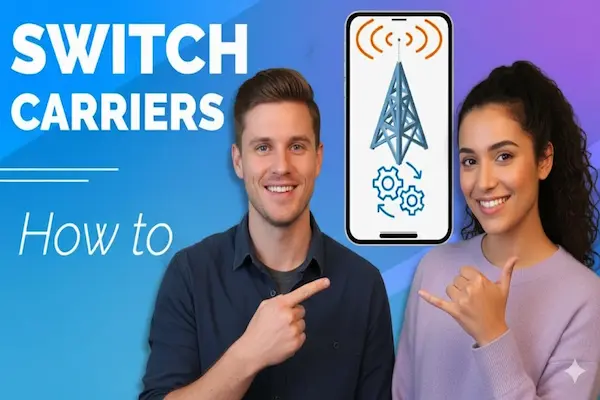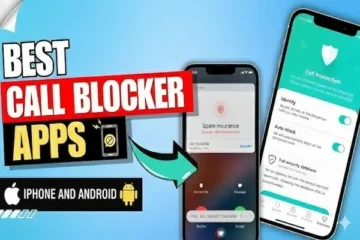Switch Carriers Without Losing Your Number
Switch carriers and keep your number in 2025 with our step-by-step checklist—eligibility, port-out PIN, eSIM setup, fixes, and FAQs for a smooth move.
Advertising
Why number portability still matters in 2025
Keeping your number protects your identity, your logins, and your relationships.
Your phone number anchors two-factor codes, banking alerts, and business calls.
Switching carriers while keeping the same number lets you save money without losing trust.
The process is called number portability, and in the United States it applies to most mobile numbers.
A clean switch relies on preparation, precise timing, and a short checklist you can complete in minutes.
This guide is independent and informational, with no affiliation to carriers or device makers.
What “switch carriers keep number” really means
You are not moving your physical SIM or eSIM to a new company, you are moving your number’s routing.
Your current carrier releases your number after verifying that you and only you requested the port.
Your new carrier imports the number and connects it to your new plan and SIM or eSIM.
Service typically overlaps for calls or texts during a brief transition window.
Porting does not cancel debt or device obligations, which must be resolved separately.

Carrier requirements you should expect before any port
Every carrier will ask for the same core identifiers to prove ownership of the number.
- Account number that uniquely identifies your line or family plan.
- Port-out PIN or transfer PIN generated by the current carrier’s process.
- Billing ZIP code and the exact account holder name as shown on statements.
- Device unlock status if you plan to bring your current phone to the new network.
- No active fraud holds or port freeze that would block number transfers.
Typical “by-carrier” expectations you can prepare for
The labels differ, but the pattern is consistent across major carriers.
- Some carriers require a one-time transfer PIN that expires within a short time window.
- Some carriers tie the transfer PIN only to the specific line, not the whole account.
- Prepaid accounts may require the original account password instead of a separate PIN.
- Business and corporate lines often need an authorized user letter or account contact approval.
- Porting a landline or VoIP number into mobile service typically takes longer than mobile-to-mobile.
Eligibility checklist before you attempt to port number
A five-minute pre-check prevents most delays and denials.
- Confirm the number is active and can place and receive calls and texts today.
- Verify the account holder name and billing ZIP exactly as the carrier stores it.
- Generate a fresh port-out or transfer PIN and note its expiration time if shown.
- Remove any voluntary port freeze or security lock placed on the account.
- Unlock the device or verify eligibility for the new carrier’s network bands and eSIM support.
- Collect your SIM ICCID or ensure the new phone supports eSIM download during activation.
- Back up your phone and confirm access to authenticator apps and recovery codes.
Timing strategy when you switch carriers keep number
Plan for a small overlap so you never lose contact during the handoff.
- Start the port earlier in the day to allow time for verification and network updates.
- Avoid holidays and late evenings when support staffing may be limited.
- Keep Wi-Fi available so messaging apps remain reachable during any brief service dip.
- Tell close contacts that you may miss a call for a short window and provide a backup method.
Step-by-step: how to port number to a new carrier
Follow this exact sequence to minimize friction and shorten the downtime.
- On your current carrier, log in and verify account details, line status, and billing ZIP code.
- Request your port-out PIN or transfer PIN and write down the expiration time if provided.
- Disable any account-level port freeze or extra fraud lock that blocks transfers.
- On the new carrier, begin the signup and select the option to transfer or keep your current number.
- Enter your current carrier name, account number, billing ZIP code, and the fresh transfer PIN.
- Choose your SIM path and either insert a physical SIM or select Add eSIM to download the profile.
- Keep the old phone and new phone powered on and connected to Wi-Fi during provisioning.
- Wait for the new carrier to confirm the number is active and assigned to your line.
- Place a test call from the new line to a known contact and ask them to call you back.
- Send yourself an SMS from another phone and reply to confirm message routing works both ways.
When calls or texts route to the wrong phone during porting
Partial routing is common for a short period and usually resolves automatically.
- If inbound calls reach the old phone, wait a few minutes and reboot both devices once.
- If SMS is missing on the new phone, toggle Airplane mode for sixty seconds and try again.
- If iMessage or RCS uses the old device, re-register your number on the new device after activation.
- If problems persist beyond the estimated window, contact the new carrier and ask them to refresh the port.
eSIM activation when you transfer number
An eSIM keeps your identity digital and avoids mistakes with plastic cards.
- Verify that your new carrier supports eSIM for your phone model and plan type.
- Keep Wi-Fi and Bluetooth on for the eSIM download and plan installation.
- Use the carrier’s QR code, device-to-device transfer, or assigned plan installation as offered.
- Confirm that your number appears Active and set the default line for data, calls, and messages.
- Remove legacy eSIM profiles only after the port is confirmed stable for calls and SMS.
Dual-SIM considerations during a carrier switch
Two lines can simplify the transition when used intentionally.
- Keep your old line on standby while the new eSIM takes over the primary data role.
- Label each line clearly as Old and New so you do not dial or text from the wrong number.
- Assign default data to the new line to push apps and updates over the new carrier immediately.
- Disable the old line only after calls and messages route consistently to the new line for a full day.
Device unlock and compatibility pitfalls
A locked phone or mismatched bands can derail a perfect port.
- Check the device lock status and request an unlock if your obligations are satisfied.
- Confirm that your phone supports the new carrier’s LTE and 5G bands, including mid-band n77 where used.
- If you rely on Wi-Fi Calling, make sure it is supported on your specific model and software build.
- Update your phone to the latest OS version so carrier settings and eSIM features are current.
Security and fraud-safe habits during number portability
Your number controls access to sensitive accounts, so treat the switch like a security event.
- Do not share your transfer PIN except inside the new carrier’s official activation flow.
- Beware of look-alike support numbers or unsolicited calls asking for verification codes.
- Use a password manager and rotate any weak passwords while you are already logged in.
- Enable number change and SIM change alerts where your device or carrier supports them.
Business, corporate, and family plan special cases
Complex accounts need an extra step or two to move smoothly.
- For corporate lines, get written authorization from the account administrator before initiating a port.
- For business numbers tied to services like fax or VoIP, confirm feature parity on the destination carrier.
- For family plans, decide whether to port all lines or split lines and document each line’s account details.
- For watch lines and tablets, check whether they can migrate or must be re-added as new devices.
Step-by-step: port number from prepaid accounts
Prepaid is portable, but the identifiers can differ from postpaid.
- Locate your prepaid account number inside the app or on receipts for the specific line.
- Confirm the account password or the prepaid transfer PIN if the carrier uses one.
- Keep the prepaid line funded and active until the port completes to avoid automatic cancellation.
- Begin the port on the new carrier and enter the prepaid credentials exactly as stored.
- Test calls and messages and then cancel any remaining add-ons on the old account if needed.
How long should a port take in 2025
Mobile-to-mobile ports are faster than landline conversions in most cases.
- Many mobile ports complete in minutes when all credentials match on the first attempt.
- Busy days, identity checks, or fraud holds can extend the window to a few hours.
- Landline or VoIP to mobile may take one to three business days and requires more patience.
- Keep both devices on Wi-Fi and avoid reboots mid-process unless instructed by support.
What does not move when you transfer number
A port moves routing, not history or entitlements.
- Past bills, credits, and device payment plans remain with the old carrier.
- Voicemail messages do not usually transfer and must be saved manually if you need them.
- Carrier-specific features may not exist on the new network even if names sound similar.
- Loyalty or bundle perks do not follow the number and must be re-enrolled if available.
Common errors and fast fixes during a carrier switch
Most failures boil down to mismatched credentials or incomplete activation.
- Error: “Invalid account number or PIN.”
Fix: Recheck the account number format and generate a fresh transfer PIN before retrying. - Error: “Port freeze or hold present.”
Fix: Disable the port freeze in security settings and try again after confirmation. - Error: “Line not eligible.”
Fix: Ensure the line is active and not suspended or canceled, then retry the port request. - Error: “Device not supported.”
Fix: Confirm band support, update software, or insert a compatible SIM in a supported device. - Error: “No service after port.”
Fix: Toggle Airplane mode, reboot, reinstall or reassign the eSIM, and verify APN settings if needed.
Messaging, iMessage, RCS, and voicemail after the port
Refresh app registrations so messages and calls stick to the new carrier.
- Open the default messages app and confirm your number is registered on the new network.
- On platforms with proprietary messaging, toggle the service off and back on to force re-registration.
- Set up a fresh voicemail box if the new carrier requires it and record a new greeting.
- Place a test call to your voicemail and ensure notifications arrive normally.
Move authenticator and banking apps safely during a carrier switch
Two-factor flows can trip you if you rush the transition.
- Sign in to your password manager on the new device before you begin the port.
- Migrate authenticator tokens using each app’s export or cloud backup method where available.
- Update the phone number on critical accounts if your number is changing, or re-verify if not.
- Keep recovery codes handy in case an app locks you out during the handoff.
When to cancel the old carrier and what to keep
Cancel only after the new line is unquestionably stable.
- Wait for a full day of normal calling, texting, and data on the new carrier.
- Save any old bills and payment confirmations for your records and trade-in credits.
- Return leased equipment or devices on time to avoid non-return fees.
- Make a final screenshot of the old account page for proof of closure if needed.
Privacy, identity, and SIM-swap awareness while switching
Attackers target number ports to hijack accounts, so stay cautious.
- Do not post that you are switching carriers until the process is complete.
- Ignore unsolicited “support” messages asking for one-time codes or transfer PINs.
- Enable account-level locks and alerts on the new carrier after activation finishes.
- Review your bank, email, and cloud accounts for unusual login prompts during the port day.
FAQ: switch carriers keep number, port number, transfer number, carrier switch, number portability
Does porting my number cancel my old carrier automatically?
In most cases the port completion triggers automatic cancellation for the line, but device payments or other lines may remain active.
How long will I be without service during the switch?
Many mobile-to-mobile ports complete with only minutes of partial service, though complex cases may take a few hours.
Can I port a suspended or canceled number?
You generally need the number active to port, so restore service before starting the transfer.
Will my voicemail and text history move to the new carrier?
Voicemail usually does not move and must be set up again, while text history lives on your device and backup, not the carrier.
What if my phone is locked to the old carrier?
Request an unlock if you meet the requirements, or use a compatible unlocked phone on the new network.
Can I switch carriers with an eSIM only?
Yes, you can download the new eSIM during activation and assign it as your primary line.
Do I need a new SIM if I keep my number?
You will typically get a new SIM or eSIM from the new carrier even though the number stays the same.
Why do calls ring on my old phone after the port?
Routing can take a short time to propagate, so reboot and wait a few minutes while networks update.
What if I entered the wrong account number or PIN?
Ask the new carrier to resubmit the port with corrected credentials and a fresh transfer PIN.
Can I port multiple lines from a family plan at once?
Yes, but each line needs its own credentials and you should label each line during setup to avoid mix-ups.
Final checklist for a smooth carrier switch
Use this simple list to confirm you are ready and protected before, during, and after the port.
- Active number confirmed with working calls and texts before you start.
- Account number, billing ZIP, and account holder name copied exactly from the old carrier.
- Fresh transfer PIN generated and any port freeze removed from the account.
- Device unlocked or verified compatible with the new carrier’s network and eSIM support.
- New SIM or eSIM ready and Wi-Fi available for activation and updates.
- Password manager signed in and authenticator app prepared for token migration.
- Port submitted early in the day with both phones charged above fifty percent.
- Test call, test SMS, and visual voicemail set up on the new carrier after activation.
- Old eSIM or SIM removed only after a full day of stable routing on the new line.
- Old account closed cleanly, trade-ins processed, and final records saved for reference.
Editorial note
This article is people-first and purely informational to help you switch carriers without losing your number.
We do not have affiliation with carriers, device makers, apps, or platforms referenced conceptually here, and features or availability may change without notice.
Validate plan policies, device eligibility, and activation steps in official sources before making changes.
With this checklist, you can execute a fast, safe, and confident carrier switch while keeping the number everyone already knows.





